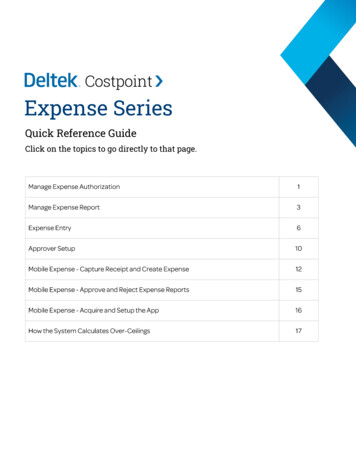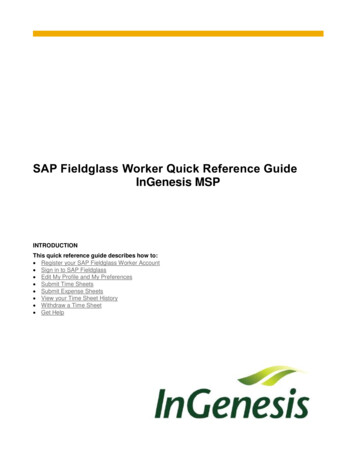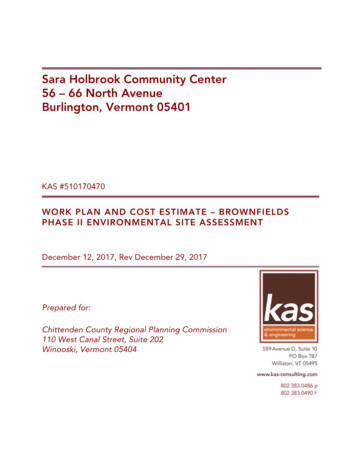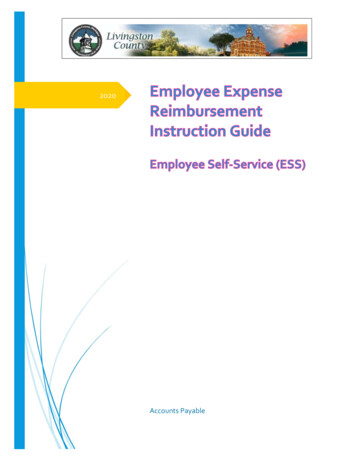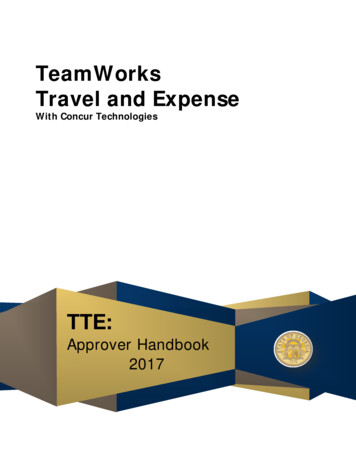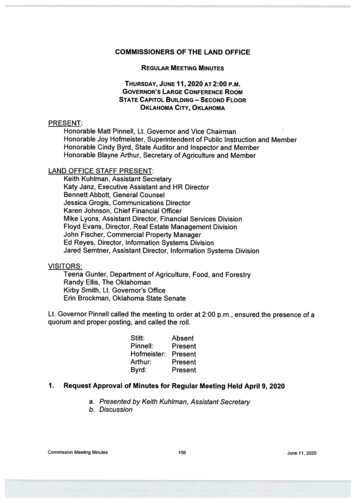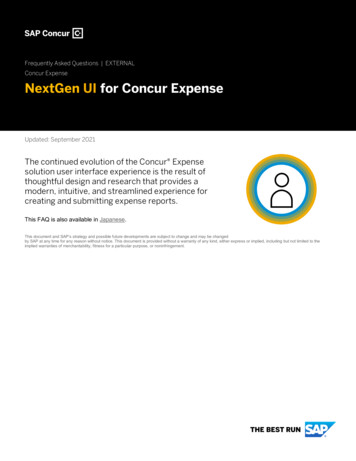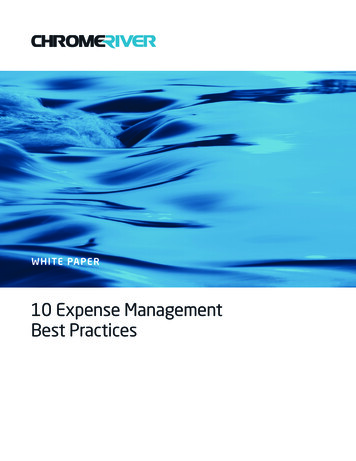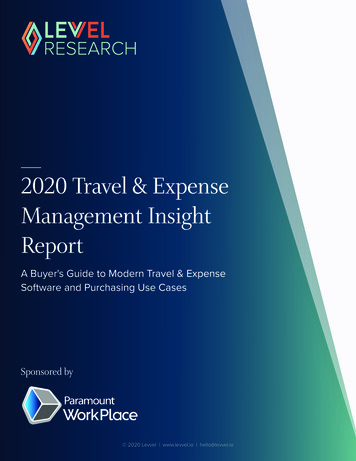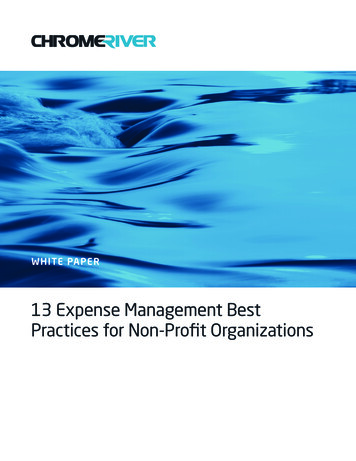
Transcription
WH I TE PAP ER13 Expense Management BestPractices for Non-Profit Organizations
13 Expense Management Best Practices for Non-Profit OrganizationsIntroductionNon-profits have a unique challenge in travel and expense (T&E) management. Every dollar spent on employee and nonemployee volunteer expenses takes a dollar away from performing its core mission. This heightened need to monitor andcontrol costs to avoid wasteful spend, means that building an effective travel and expense policy is even more critical.Whether you are planning to write your first travel and expense policy or you are a travel veteran who has had one in placefor many years, it’s always good to look outside your own bubble and see what other non-profit organizations are doingto effectively manage their employee and non-employee volunteer spend. This process enables you to refine and enhanceyour own expense management program and incorporate these best practices.The best-performing T&E policies and programs are customized for each organization. Best practices need to be defined,implemented and tailored to the organization’s specific needs in order to have a successful expense management process.Chrome River is trusted by more than 50 non-profits around the world, from regional, community-focused groups tomajor organizations with thousands of employees and non-employee volunteers. We have a deep understanding of thechallenges and issues specific to the non-profit sector, and work with our customers to develop and implement expensemanagement programs tailored to their specific travel needs.This guide is based on more than a decade of direct experience. It covers 13 of the most effective expense managementbest practices, which have been collected first-hand from a wide range of non-profits around the world, and could have ameaningful benefit to any organization’s T&E programs.1. Implement a Per Diem Systemexample, should an individual choose to dine at a Michelin-Per diems are commonly used by non-profit organizations, as theystarred restaurant, they will be responsible for any costs overoffer a simple way for finance teams to pay and account for T&Ethe per diem allocation, and there is no mechanism for them tospend. Rates are set by location based on government-specifiedreclaim the excess spend.calculations for both domestic and international locations. Thisensures that travelers have a sufficient allowance to cover theircosts, even when traveling to high-cost locations such as London,San Francisco or Tokyo. They take a variety of factors into account,ranging from average hotel bills to meal and transportation costs.Per diems are typically secured in advance through a pre-approvalprocess [see below], and can be offered either as a direct cashadvance or by (re-)loading a payment card. In addition to offeringan efficient way for travelers to make purchases, per diemsalso offer an effective cost-control safeguard for the issuingorganization, ensuring that individuals can’t misuse the expenseprocess by making out-of-policy purchases. As an extremewww.chromeriver.com2. Require Pre-ApprovalsMandating pre-approvals for travel and other large purchasescan greatly reduce the opportunity for over-spend—eitherinadvertently or through deliberate expense abuse. This isparticularly effective when combined with per diems, whichprovide a full audit and approval trail for travelers’ spend.Pre-approvals often work in conjunction with an organization’spurchasing card program, or a “ghost” card (a single, centralizedcard number used across a department or organization) fortravel booking. Although travelers can browse and select their
13 Expense Management Best Practices for Non-Profit Organizationsitems/tickets, they can’t complete the purchase until approved by a supervisor. These systems work by alerting approvers (whomay differ for different transactions, dependent on the size ofthe purchase, per the organization’s policies) of a pre-approvalExcess reimbursements are returned within 120 days after theexpense is paid or incurred An employee provides an adequate accounting of outstandingadvances within 120 days of receiving a periodic (at leastrequest. The approver (or approvers) must then give theirquarterly) statementapproval prior to the purchase being made or the travel booked.As an additional requirement in developing an accountable plan,Another example of leveraging pre-approvals to streamline theIRS Code Section 274(d) states that substantiation requires anoverall process, is using it as the starting point for an expenseemployee to submit the following items with adequate recordsreport. Travelers can submit a pre-approval request through(such as receipts):the system for a specific purchase or an entire trip. Once the trip is complete, the approved pre-approval can be “flipped”to an expense report, and transactions related to the tripare automatically allocated to the report within the expensesolution. This eliminates duplicate entry of trip informationand further streamlines the accounting and reconciliation/According to the IRS, every organization’s expense reimbursementor allowance arrangement must include all of the following rules,to be considered having an accountable plan:1. The expense must have a business connection. Deductibleexpenses must be incurred while performing services as anemployee on behalf of the employer.2. Expenses must be submitted promptly. Expenses must beadequately accounted for within a reasonable period of time.3. Overpayment of expenses must be returned in a timelymanner. Any excess reimbursement or allowance paid to anemployee must be repaid to the employer within a reasonablefacts and circumstances of the situation. However, actions thatPurpose of the expenseProfessional relationship of the employee to the personsor propertyGiven all these rules and regulations, it’s extremely importantthat organizations review their travel policy and guidelinesdocumentation with employees on a regular basis as updatesoccur, or at least on an annual basis.4. Initiate a Credit Card ProgramEmployer-provided “corporate” card (or p-card, travel card,meeting card, and/or virtual card) programs are plentiful andhighly competitive, and offer numerous financial and operationalbenefits. Here are just a few of the many benefits a good cardprogram can offer: Financial incentives and rebates for all purchases. Corporatecards offer a cashback rebate for all spend, which can deliverperiod of time.The definition of “reasonable period of time” depends on theTime and place of the expensereceiving a gift, being entertained, or utilizing a facilityreimbursement process.3. Build an Accountable PlanAmount of the expensesignificant benefits—in fact larger organizations can receivesix-figure rebates on their annual card purchases. Corporate cards reduce the cost of expense report handling.take place within these timeframes will be treated as takingBy integrating card data into T&E systems and automaticallyplace within a reasonable period of time:reconciling receipts with card data, the need for employees to rekey their expenses is eliminated, and the accuracy of theAn advance is received within 30 days of the time an expenseis incurred Expenses are adequately accounted for within 60 days afterthey are paid or incurredcaptured data is improved. This reduces the time employeesspend creating expense reports, and the time approversspend ensuring compliance.
13 Expense Management Best Practices for Non-Profit Organizations The use of corporate cards reduces the number of falsifiedall expenses are validated upfront against the organization’sreceipts. An example of this is a dinner bill that includes a 10expense policy, as well as any parameters specific to any grantpercent tip, but the employee turns in a claim for a 20 percentallocation which may be funding the expense.tip. Using an employer-provided card eliminates both theincentive and means to do so. Carrying a corporate card eliminates the need for cashadvances, which not only streamlines processes for theorganization but also eases the process for the travelersthemselves.With an automated process, when a traveler attempts to enteran expense that is not compliant with policy, the expense itemis immediately flagged. Depending on the type of infraction,the traveler may be asked to provide an explanation. Approversdetermine the outcome or may remove the item from theexpense report altogether. If personal items are charged to anA common concern that organizations have about corporateorganization-paid corporate card, expense owners can markcards is that employees can incur charges on their corporatethe item as personal, in which case the expense is automaticallycard (and therefore the organization’s liability). This fear can bededucted from their out-of-pocket reimbursement.mitigated by reminding employees through your expense policythat legitimate expenses will be paid provided they submit timelyexpense claims for those charges. Reinforcing a policy that deniesreimbursement of expenses for late submissions, regardless ofwhether it’s an employee liability card charge or an employerliability card charge, is usually plenty of motivation for most users.Organizations can also eliminate any concern about illegitimatecard use by providing pre-loaded physical or virtual cards basedon per-diems or pre-approvals. This enables them to offer theconvenience of an employer-provided card without the liability ofexcess spending.Finally, if you combine your card program with an automatedexpense management system, your organization will havefull visibility into every card transaction, minimizing the riskof duplicate reimbursement if someone accidentally submitsa receipt separately for a transaction that was paid via anorganization liability card program. This visibility minimizesmisuse concerns as well since compliance rules are automaticallyenforced as mentioned below.5. Automate Policy EnforcementEnforcing policy in a spreadsheet-based environment typicallyinvolves several employees verifying expenses, who could beadding more value to the organization in other ways. Usingan expense management system, expense policy compliancerules are applied through the use of a ‘rules engine,’ ensuringwww.chromeriver.com6. Clearly Document the Approval ProcessMany organizations’ expense approval processes aren’t codifiedor communicated effectively, which can lead to reimbursementdelays and other inefficiencies. By taking a step back andthinking about roles, responsibilities, and delegation ofauthority, it becomes easy to build an approval matrix thatcan be automated within an expense management solution—particularly one that employs a sophisticated business rulesengine that can handle virtually any combination of criteria.Approval routes can be built based on hierarchy, transactionvalue thresholds, expense allocation coding/grants, attributesof the expense owner, and many additional criteria. Typicalapproval routing should have two to four levels of approval. Toofew approval levels and organizations may not be adequatelyreviewing their expenses. Too many, and it becomes complex toexecute and maintain. Most organizations prefer accounts payablestaff serve as the final step in the approval process before theapproved voucher is exported to the financial system for payment.7. End Penny-Wise-and-Pound-FoolishAudit PracticesAuditing 100 percent of expense reports is poor use of timeand resources, and gives the finance team a false sense ofsecurity. To ensure an effective auditing practice, accountspayable groups need to take a more methodical and calculatedapproach. An important decision to make is who is performing
13 Expense Management Best Practices for Non-Profit Organizationsthe audit: accounts payable or audit staff? Organizations need to determine a statistically valid sample size for auditing andthen have auditors—not accounts payable staff—meticulouslyexamine expense reports and receipts. This analysis should coverDo not allow future-dated travel that is not charged to acorporate charge card. Establish a policy that requires the most senior employee at ameal to pay the check, to avoid the potential for collusion.the details of the current report and a three- to six-month rangeof expenses for a specific expense owner.9. Take Care of Your TravelersExpense owners who fail the audit should be assigned to a riskMany non-profits with international operations requirecategory, for example rated from 1-5. Someone who is assignedemployees and non-employees to travel to and work inrisk category five would have all of their reports audited, wherechallenging environments. These could include anything fromexpense owners assigned risk category one would only haveconflict/refugee situations to natural disasters or areas of diseaseevery tenth report sampled for an audited. Each organizationoutbreak. Ensuring the physical safety of these travelers is ofneeds to determine their appropriate statistical sampling.paramount importance, and travel risk management/duty ofWhen an audit is completed, audited expense owners shouldreceive an email informing them of any issues that need to bereviewed or congratulating them on being in compliance withcare is becoming more important than ever in a world that isbecoming increasingly volatile due to geopolitical tensions andan ever-changing climate.organization policies and guidelines. Conducting independentAn effective duty of care plan requires both pre-travel planningaudits and discussing the results with employees has the powerand on-trip monitoring. There are a number of solutions whichto change behavior across the organization.collect crime/public safety, health, terror, conflict, and otherweather/climate-related risk data for locations worldwide,8. Help Employees Make Good DecisionsHow often do people cheat on their expense reports? Five percentof travelers admit to inflating or falsifying expenses, which caneasily add up to many thousands of dollars of fraudulent spendfor large non-profits. Research from Chrome River shows that fewof the people who submit illegitimate expenses do so becauseand provide this to organizations on a subscription basis. Thisinformation can then be integrated with a travel booking tool oran expense system’s pre-approval module to alert approvers ofpotential risks and give an overall risk score. Approvers can thenweigh the benefit/need for travel versus the risks that it presentswhen making their decision.they have an agenda of defrauding their employer. Many areOnce a traveler is on their trip, the travel risk managementopportunistic and do so because their expense processes makesolution, combined with flight and hotel data from the travelit easy. As such, changing the behavior of these travelers is oftenbooking solution, can be used to forewarn and quickly alertmore a case of helping them to do the right thing. There aretravelers of potential issues that could impact their travel.several straightforward fixes that organizations can implement tohelp reduce fraudulent expenses being reimbursed: Require one expense report per trip so expenses areeasier to track. 10. Centralize the Travel Expense ProcessMany of the processes described in this guide can onlybe put into place with the implementation of an expenseIssue corporate cards to frequent travelers. This reduces the riskmanagement solution. Prior to implementing an automatedof the organization never receiving credit for cancelled flights,expense management solution, most organizations requireas well as other types of potentially fraudulent transactions.a huge amount of manual intervention to properly validateImplement an expense management solution that canexpenses against their T&E policy, and ensure these expensesautomatically identify many types of attempted expense fraud.are routed to the appropriate approvers prior to payment. In
13 Expense Management Best Practices for Non-Profit Organizationslarge organizations, this can add up to considerable numbersof people spread across departments and campuses. Byimplementing an automated expense management platform,a consistent, programmatic approach replaces a substantialamount of human intervention: 11. Make Life Easy for Your Non-EmployeeVolunteersMany non-profit organizations have a significant number ofnon-employee volunteers who are required to submit expenses,so the expense process should make supporting these groupsExpenses are validated against the organization’s policy (asstraightforward. A best-practice approach for this involveswell as rules for any grant that is paying for the travel) at thecollecting 1099 forms from approved non-employees, and thentime of expense entry, and employees can either be preventedsimply importing the list into the expense reporting solution.from submitting a non-compliant expense (‘hard stop’) orThe system can then be configured so that the expense reportthey can be required to provide an explanation that will allowtype can be created, applying specific policies, expense types, GLthe approver to decide if full, partial, or zero reimbursementallocations, and so on.should be provided (‘soft stop’). Approval routing rules are applied based on attributes ofthe expense items or the entire report itself (e.g. allocationdepartment, cost center, project, grant, amount). Byemploying a rules engine, the combinations of standardrouting and exception routes are almost unlimited yet easy tocreate and maintain. Once non-employees’ names are in the system, they typicallysubmit receipts to a central administrator, based on the businessrules already in place. Organizations can configure the expensesolution to specify allowable reimbursements, or even adjustpermissions so reports can be submitted by an authorized useron behalf of non-employees.Possible duplicate expenses can be flagged at the time ofReimbursement of non-employee volunteers also needs toexpense entry or audited as part of analytics reporting.be effectively managed, as they are paid as “vendors” insteadApprovers can now focus on ensuring that proper allocationsof employees. It’s incumbent upon the organizations towere provided for the expense and spend is appropriate, versusminimize the time between invoice receipt and reimbursement.having to worry about compliance to the organization’s policy.Leveraging a solution which has close integrations with globalAccounting and/or accounts payable can be inserted as thelast “approved for payment” approver and have completevisibility to any policy violations, explanations, managementpayment solutions, such as Western Union, enables a speedy andsmooth payment solution, and also minimizes any risks posed bycurrency fluctuations.approvals, notes and threaded dialogue included along with copies of all receipts.12. No Cutting ChecksFollowing final approval, approved expenses are automaticallyIn addition to being an unnecessary use of natural resources totransferred to the organization’s financial system and no longercreate and mail hard copy checks, doing so also has the potentialhave to be re-keyed into the financial system for payment.to undo some of the benefits you derived from automatingeverything up to that point. Organizations engaged in best-As different grants require greater or lesser levels of granularitypractice expense management behaviors are moving towardwhen it comes to managing and reporting spend, an expenseautomated ACH or EFT payments of all expenses. Here’s why:management solution must have the capability be configured to meet specific needs. This requires the solution to have theduplicate payments and fraud increases when expenses areflexibility and strength to support multiple business rules,tailored for each grantor. For complex and high-volumeproject tracking, organizations will also require the flexibility toautomate, filter and easily allocate to various projects.www.chromeriver.comReduce duplicate payments and fraud: The potential forpaid by check. Reduce processing time: The processing time for purchase,payment and reconciliation is reduced significantly as theoverall AP process becomes more efficient.
13 Expense Management Best Practices for Non-Profit Organizations More timely payments: An important accompanying benefit Analyzing spend by expense category to uncover opportunitiesof reduced processing time is more timely payments that canfor ‘strategic sourcing.’ By evaluating total spend on certainresult in more satisfied employees.types of expenses (e.g. flights, hotels, car rentals), it mayStreamline reporting: Electronic payment data reportingbenefit an organization to develop a preferred relationshipimproves information flow by reducing the need for manualwith one or more key suppliers. Knowing volume and beinginputs while increasing reporting accuracy and improvingable to commit some of that volume are the keys to drivingprocess efficiency.significant savings that often exceed 20 percent of total spend.Improve spend analysis: More comprehensive electronic The ability to analyze and visualize spend patterns throughdata reporting on the organization’s payables improves thea straightforward visual interface makes it significantlyorganization’s spend analysis and fosters better expenseeasier to spot trends than poring through countless rows onmanagement.spreadsheets. These insights can include hotspots in areassuch as out-of-policy or inefficient spend, which can then beEnhance compliance: The automation generated by electronicused to eliminate pockets of non-compliance, address policypayments increases the transparency of the AP process andfosters greater compliance with the organization’s policies,procedures and IRS regulations.gaps, or be fed back into future expense policies. Reports that pull together in-process card and out-of-pocketspend that are not yet exported from the expense managementtool to your financial system can provide tremendous insight13. Leverage Your LeverageOnce an automated expense management solution thatincludes some or all of the best practices mentioned above isimplemented, it is time to ‘leverage your leverage’ through theuse of analytics and business intelligence reporting. The fact thatthousands or millions of spend dollars flow through this highlyvisible environment provides an outstanding opportunity forfinancial and operational improvements, such as:into accruals and assist with period-end close. Key performance indicators such as open approvals agingcan help spot and remedy bottlenecks in processes that arecausing delays in reimbursement cycle times. Compliancereporting can help spot individuals and groups that areat higher risk for policy violations, as well as providingmeaningful insights into which the organization’s policies mayrequire further education and training.conclusionMany organizations are still dealing with manual expense management processes that make it time-consuming andchallenging to handle employee (and non-employee) reimbursements, cash advances, card program reconciliation, andtraveler safety. Increasingly though, many organizations are starting to prioritize expense management automationprojects so that they can help employees and non-employee volunteers get back to their main mission—providing muchneeded services for vulnerable groups in challenging situations. The benefits to understanding best practices for expensemanagement allow organizations to do exactly that, all while increasing traveler satisfaction.It is important to choose an expense management automation platform that will allow your organization to continue toevolve and grow into new ways of handling travel and expense management. A flexible, modern platform built on currenttechnology standards is the best way to ensure that.
Chrome RiverChrome River provides expense and invoice automation solutions that let businessflow for more than 1,000 organizations worldwide. The company’s easy-to-use,enterprise-scale solutions enable future-readiness for its customers. As a result ofthis focus on innovation, Chrome River is rated as a Leader in expense managementby analyst firm IDC. Chrome River’s commitment to delivering a superior customerjourney by creating long-term value for its customers, makes it a preferred choiceof CFOs, CIOs, AP teams, travel managers and business travelers. Details on ChromeRiver’s customers can be found on the company’s web site.To find out why more than 2 million business travelers around the world trust ChromeRiver, contact the company at 888-781-0088, or visit chromeriver.com and its socialpages on LinkedIn, Facebook, Twitter, and Instagram.info@chromeriver.com 1.888.781.0088info-ca@chromeriver.com 1.416.697.7590info-uk@chromeriver.com 44 (0) 20.7846.0166info-de@chromeriver.com 49 (69) 5680 7178info-au@chromeriver.com 61.2.9331.6809
13 ExpEnsE ManagEMEnt BEst practicEs for non-profit organizations www.chromeriver.com INtrOductION Non-profits have a unique challenge in travel and expense (T&E) management. Every dollar spent on employee and non-employee volunteer expenses takes a dollar away from performing its core mission. This heightened need to monitor and
